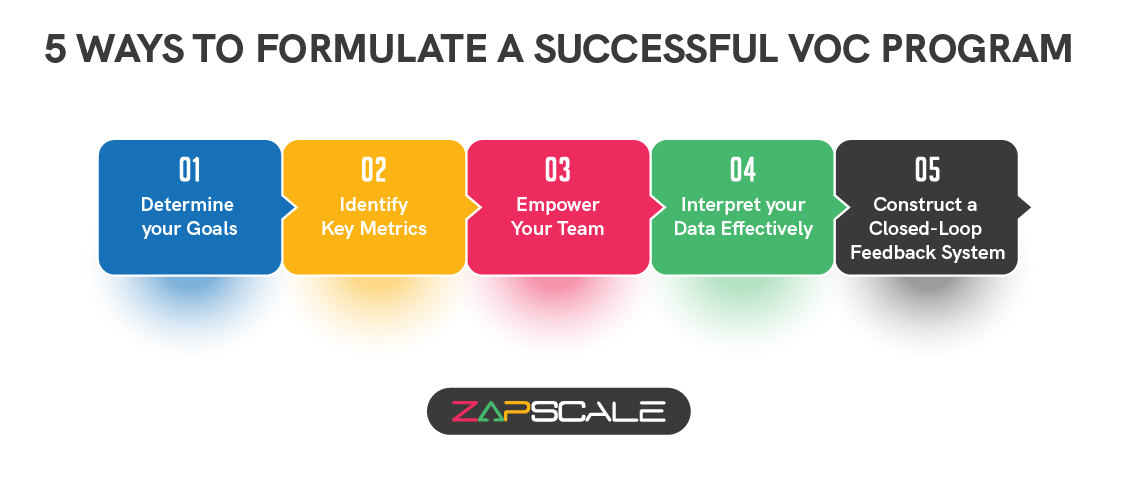CATEGORY > Customer Success Management
A Deep Dive into Voice Of The Customer (VoC)

Today’s customers are smart, demanding, and expect the best.
Moreover, present customers are picky and spoiled for choices, thus, making businesses prioritize personalized customer experience more than ever before.
Let’s learn more about VoC and how it can be implemented for continual business advancement.
What Is The Voice Of The Customer?
Voice of the customer entails actively listening to customer feedback, understanding individual experiences, and taking action.
An ideal voice of the customer example would be of a software firm that improves user features based on customer feedback to increase usability and reduce support issues, resulting in stronger customer relationships.
Modern firms deploy VoC programs to improve their products, services, and customer experiences.
Unlike past methods, VoC prioritizes individual feedback and engages the entire company in improving customer experience.
Businesses use technologies such as text analytics and sentiment analysis to acquire insights that improve satisfaction and loyalty through responsive, customer-centric initiatives.
How Does VoC Pay For Itself?
With the aid of the VoC framework, present organizations can understand their customers' requirements, preferences, and expectations in a much more convenient and reliable way than before.
Let’s learn about some of the proven advantages of incorporating VoC into an establishment.

1. Improved Customer Experience
VoC allows companies to get direct feedback from customers to help them identify pain points and areas for improvement faster.
By resolving these challenges, organizations can improve overall customer happiness, resulting in more customer loyalty and retention.
This enables businesses to discover and resolve any friction spots that hamper the customer experience.
2. Healthy Customer Relationships
For any business, the relationship they share with their customers comes before the actual sales.
As we all know, all relationships require transparent and continual communication to foster.
VoC programs create a two-way communication channel, making customers feel valued and heard.
Businesses that actively seek and respond to feedback exhibit a dedication to customer satisfaction. This promotes trust, loyalty, and stronger connections with the customers.
3. Augmented Products
Ultimately, it’s the customers who are using your products/services and hence they’re the ones who can give you a better account of your offerings.
Customer feedback from VoC programs replaces guesswork with real-time insights, which improves product development.
Businesses use this data to identify improvements, usability concerns, and product designs that perfectly fit customer desires, driving innovation and competitive advantage.
4. Customer-Centric Culture
Hands down, implementing VoC activities promotes a customer-centric culture within a firm.
VoC initiatives can significantly improve overall customer satisfaction by simplifying operations and eliminating user pain points.
When employees are regularly exposed to customer feedback and understand how their actions affect customer satisfaction, they become more sensitive, empathetic, and proactive in meeting customer requirements.
5. Brand Loyalty And Advocacy
Satisfied customers are more likely to become committed brand ambassadors. VoC assists organizations in identifying and nurturing these champions by consistently meeting or exceeding their expectations, which strengthens brand loyalty.
Responding to consumer feedback displays your dedication to continual improvement.
This proactive approach builds a favorable brand image and establishes the organization as one that cares for its customer base.
Role Of VoC In Customer Success
The voice of the customer is indeed a promising hero in the realm of customer success!
But, how? Let’s find out below.

1. Reduced Customer Churn
Consistently acting on customer feedback helps you retain significant customers, resulting in long-term profitability and growth through proactive involvement.
VoC programs reduce churn by responding quickly to issues and proactively identifying at-risk customers.
This technique enables customized interventions, which develop stronger relationships and increase overall customer satisfaction.
2. Customer Empowerment
Businesses that provide relevant information build stronger relationships, develop loyalty, and drive long-term success.
VoC programs educate customers about updates, best practices, and upgrades, which improves competency and satisfaction.
This proactive strategy improves satisfaction, enhances product adoption, and reduces churn risk.

3. Improved Product Adoption
VoC initiatives increase product uptake by getting extensive consumer feedback.
CS teams identify low-adoption areas and plan targeted advertising and education. Proactive service and feature promotion increase customer pleasure and loyalty.
Strengthening relationships and understanding consumer preferences ensures long-term growth and higher product value.
4. Data-Driven Decision Making
Voice of the customer programs employs data to better understand customer demands and transform decision-making for customer success.
Businesses may tailor their tactics, improve customer satisfaction, and increase loyalty by gathering legitimate feedback.
Aligning efforts with customer expectations supports long-term growth and success in competitive marketplaces.
5. Competitive Intelligence
VoC programs use social listening to gather competitive information by comparing customers' impressions of products to those of competitors.
This assists teams in identifying strengths and shortcomings, as well as refining marketing methods to boost competitiveness and customer relationships, supporting long-term success through agile, user-focused initiatives.
Voice Of Customer Programs - Decoding The Basics
A voice of the customer program involves certain activities for its successful effectuation.
Here, we’ll talk about the 3 crucial stages that constitute a basic VoC Strategy
Stage 1 - Listen
The initial stage of a VoC program entails actively listening to customers using surveys, interviews, and social listening.
Success at this stage depends on reaching out to the right people, asking relevant questions, and properly scheduling feedback requests.
Simplify the feedback procedure to encourage regular involvement.
It's a smart idea to time your surveys at crucial stages in the customer journey, such as after implementation or support interactions, to ensure valuable insights and enhance overall data quality.
Stage 2 - Respond
The next stage of a voice of the customer program highlights the vitality of communication.
Respond to customer issues quickly to display attentiveness and increase loyalty.
Adopt a "closed-loop" communication strategy to respond quickly to any comments, whether positive or negative.
Use a high-touch/low-touch framework to provide personalized outreach to key accounts while communicating efficiently with fewer clients.
Create VoC playbooks to standardize feedback processes, and use CRM tools to streamline interactions.
Create a company-wide culture that values customer input to motivate continual improvement and customer-centric tactics.
Stage 3 - Assess
Finally, the last stage of a VoC program is all about doing some actual work - gauging the given data.
Make sense of your data by identifying patterns and trends that can lead to actionable insights.
Concentrate on areas like business analytics (analyze NPS trends and response times) and outreach analytics to get a clearer picture of your customer base.
Use technologies to extract valuable insights from text-based feedback, improving understanding of the customer experience and leading continuous improvement efforts for long-term success.
Transmuting the Business landscape with the Voice of Customer (VoC)
The tide is shifting in the business world!
Companies are abandoning obsolete procedures in favor of a powerful tool - VoC or the voice of customer programs.
In today's challenging business world, corporations are implementing voice-of-customer initiatives to listen to their customers and improve their business practices.
Voice of customer programs are transforming the business landscape by placing customers at the forefront of their decision-making process.
VoC goes beyond gathering basic comments from a random group of customers.
It’s a highly sophisticated or strategic process!
Companies that analyze data from surveys, interviews, and social media can reveal hidden customer requirements, prioritize issues based on effect, and even identify prospective product champions.
This data is also utilized to tailor customer support interactions, create online communities for knowledge sharing, and assess the effectiveness of customer-focused projects.
Organizations that pay careful attention to their customers and strategically use VoC data remain ahead of the competition, build a customer-centric culture, and ultimately generate innovation that keeps customers happy and loyal.
Top 5 Ways to formulate a successful VoC Program
Here are 5 ways to help you create the right voice for the customer program.

1. Determine Your Goals
Define specific goals (such as customer satisfaction, churn reduction, and product enhancement) to link VoC initiatives with business priorities and ensure focused and effective implementation.
2. Identify Key Metrics
Choose metrics like NPS, CSAT, and retention rates to quantify customer sentiment and properly track progress in your VoC program.
3. Empower Your Team
Train and give resources to customer-facing teams on how to properly gather and use feedback, establishing a customer-centric culture across the organization.
4. Interpret Your Data Effectively
Analyze feedback regularly to identify trends and areas for improvement, ensuring that proactive solutions to customer requirements are effective.
5. Construct A Closed-Loop Feedback System
Create a closed-loop method for swiftly responding to and following up on customer feedback, displaying responsiveness and value for customer input.
Voice of Customer Strategy - Questions that COUNT
Before concocting your voice of the customer strategy, you must pay heed to these questions below.
Q1. Who are your target customers and what are their demographics?
Q2. What are the primary goals and objectives of your VoC strategy?
Q3. How do customers use your products/services in their daily lives?
Q4. What do customers like most about your offerings?
Q5. How do customers prefer to provide feedback?
Voice of Customer (VoC) Programs - Best Practices to Follow
To perfect your voice in customer programs, you must prioritize these practices mentioned below.
1. Pick Apt Approaches
Use a combination of qualitative and quantitative methodologies like surveys, interviews, focus groups, and social media monitoring.
Each technique provides distinct insights that provide a thorough view of customer feedback.
2. Evolve Continuously
Treat your VoC program as a continuous process, rather than a one-time project. Continuously solicit input on the program and adjust approaches to respond to changing customer expectations and market realities.
3. Train & Engage Your Team
Train your employees to successfully gather customer feedback, interpret insights, and use them to drive operational improvements, enabling proactive engagement in improving customer experience and service quality.
4. Embrace A Customer-Centric Culture
A strong VoC program extends beyond data collection.
Develop a company culture that values customer input at all levels.
This guarantees that everyone is committed to knowing and addressing customer needs.
5. Follow A Closed-Loop Feedback System
Implement a closed-loop feedback procedure in which customers are acknowledged and updated on actions made in response to their comments. This not only increases transparency but also promotes trust and loyalty.
6. Concentrate On Quality Over Quantity
Avoid bombarding customers with surveys.
Create brief, specific inquiries that go to the heart of the matter. High-quality feedback with particular specifics is preferable to a huge number of generic comments.
Conclusion
To sum up, the voice of the customer programs empowers your business with authentic and powerful customer data, leading to success and long-term customer relationships.
ABOUT THE AUTHOR
Popular from Customer Success Management
Quality Content,
Straight To Your Inbox!
Subscribe for the latest blogs, podcasts, webinars, and events!

Write a Blog
If you have experience in CS and
a flair for writing, we’d love to
feature you.
Write to us on
hello@zapscale.com





